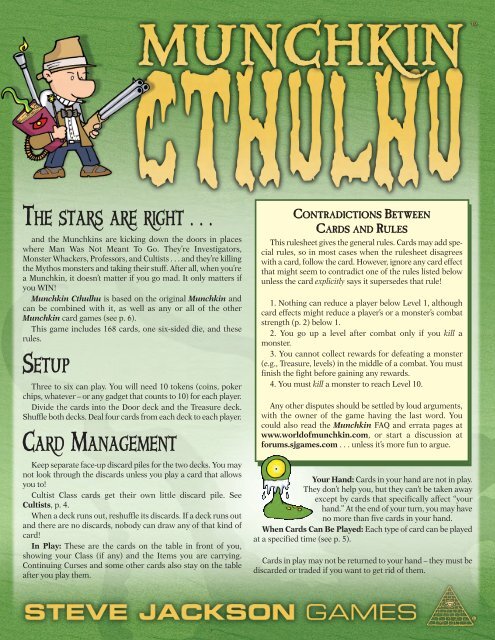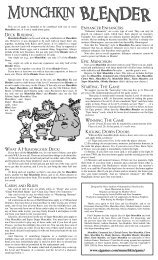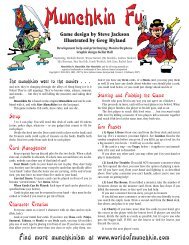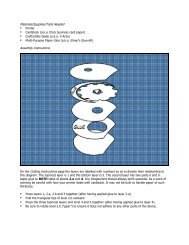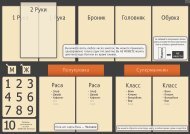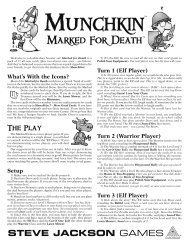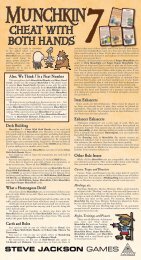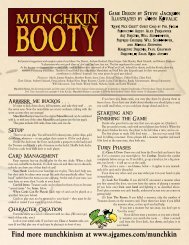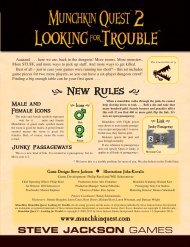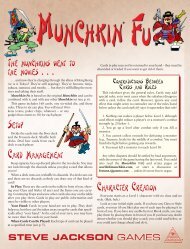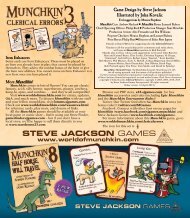You also want an ePaper? Increase the reach of your titles
YUMPU automatically turns print PDFs into web optimized ePapers that Google loves.
THE STARS ARE RIGHT . . .<br />
and the <strong>Munchkin</strong>s are kicking down the doors in places<br />
where Man Was Not Meant To Go. They’re Investigators,<br />
Monster Whackers, Professors, and Cultists . . . and they’re killing<br />
the Mythos monsters and taking their stuff. After all, when you’re<br />
a <strong>Munchkin</strong>, it doesn’t matter if you go mad. It only matters if<br />
you WIN!<br />
<strong>Munchkin</strong> <strong>Cthulhu</strong> is based on the original <strong>Munchkin</strong> and<br />
can be combined with it, as well as any or all of the other<br />
<strong>Munchkin</strong> card games (see p. 6).<br />
This game includes 168 cards, one six-sided die, and these<br />
rules.<br />
SETUP<br />
Three to six can play. You will need 10 tokens (coins, poker<br />
chips, whatever – or any gadget that counts to 10) for each player.<br />
Divide the cards into the Door deck and the Treasure deck.<br />
Shuffle both decks. Deal four cards from each deck to each player.<br />
CARD MANAGEMENT<br />
Keep separate face-up discard piles for the two decks. You may<br />
not look through the discards unless you play a card that allows<br />
you to!<br />
Cultist Class cards get their own little discard pile. See<br />
Cultists, p. 4.<br />
When a deck runs out, reshuffle its discards. If a deck runs out<br />
and there are no discards, nobody can draw any of that kind of<br />
card!<br />
In Play: These are the cards on the table in front of you,<br />
showing your Class (if any) and the Items you are carrying.<br />
Continuing Curses and some other cards also stay on the table<br />
after you play them.<br />
CONTRADICTIONS BETWEEN<br />
CARDS AND RULES<br />
This rulesheet gives the general rules. Cards may add special<br />
rules, so in most cases when the rulesheet disagrees<br />
with a card, follow the card. However, ignore any card effect<br />
that might seem to contradict one of the rules listed below<br />
unless the card explicitly says it supersedes that rule!<br />
1. Nothing can reduce a player below Level 1, although<br />
card effects might reduce a player’s or a monster’s combat<br />
strength (p. 2) below 1.<br />
2. You go up a level after combat only if you kill a<br />
monster.<br />
3. You cannot collect rewards for defeating a monster<br />
(e.g., Treasure, levels) in the middle of a combat. You must<br />
finish the fight before gaining any rewards.<br />
4. You must kill a monster to reach Level 10.<br />
Any other disputes should be settled by loud arguments,<br />
with the owner of the game having the last word. You<br />
could also read the <strong>Munchkin</strong> FAQ and errata pages at<br />
www.worldofmunchkin.com, or start a discussion at<br />
forums.sjgames.com . . . unless it’s more fun to argue.<br />
Your Hand: Cards in your hand are not in play.<br />
They don’t help you, but they can’t be taken away<br />
except by cards that specifically affect “your<br />
hand.” At the end of your turn, you may have<br />
no more than five cards in your hand.<br />
When Cards Can Be Played: Each type of card can be played<br />
at a specified time (see p. 5).<br />
Cards in play may not be returned to your hand – they must be<br />
discarded or traded if you want to get rid of them.
CHARACTER CREATION<br />
Everyone starts as a Level 1 character with no class. (We never<br />
get tired of that joke.)<br />
Look at your initial eight cards. If you have any Class cards,<br />
you may (if you like) play one by placing it in front of you. If you<br />
have any usable Items (p. 5), you may play them by placing them<br />
in front of you. If you have any doubt about whether you should<br />
play a card, you could read below, or you could just charge ahead<br />
and do it.<br />
STARTING AND<br />
FINISHING THE GAME<br />
Decide who goes first in any way you can agree on. (Snicker.)<br />
Play proceeds in turns, each with several phases (see below).<br />
When the first player finishes his turn, the player to his left takes<br />
a turn, and so on.<br />
The first player to reach 10th level wins . . . but you must reach<br />
10th level by killing a monster, unless a card specifically allows<br />
you to win another way.<br />
TURN PHASES<br />
At the start of your turn, you may play cards, switch items<br />
from “in use” to “carried” or vice versa, trade items with other<br />
players, and sell items for levels. When your cards are arranged<br />
the way you want, go to phase 1.<br />
(1) Kick Open The Door: Draw one card from<br />
the Door deck and turn it face up.<br />
If it’s a monster, you must fight it. See<br />
Combat. Resolve the combat completely<br />
before you go on. If you kill it, go up a<br />
level (or two, for some especially nasty<br />
monsters!) and take the appropriate<br />
number of Treasures.<br />
If the card is a curse – see Curses, p. 5<br />
– it applies to you immediately (if it can)<br />
and is discarded.<br />
If you draw any other card, you may either<br />
put it in your hand or play it immediately.<br />
(2) Look For Trouble: If you did NOT draw<br />
a monster when you first opened the door, you now have the<br />
option of playing a monster (if you have one) from your hand<br />
and fighting it, just as if you had found it when you kicked open<br />
the door. Don’t play a monster you can’t handle, unless you’re<br />
sure you can count on getting help!<br />
(3) Loot The Room: If you did not find a monster by kicking<br />
open the door and you did not Look For Trouble, you loot the<br />
room . . . draw a second card from the Door deck, face down,<br />
and place it in your hand.<br />
If you met a monster but ran away, you don’t get to loot the<br />
room.<br />
2<br />
(4) Charity: If you have more than five cards<br />
in your hand, you must play enough of them to<br />
get down to five, or give the excess to the player<br />
with the lowest Level. If players are tied for lowest,<br />
divide the cards as evenly as possible, but it’s up to<br />
you who gets the bigger set(s) of leftovers. If YOU<br />
are the lowest or tied for lowest, just discard the<br />
excess.<br />
It is now the next player’s turn.<br />
COMBAT<br />
To fight a monster, compare its combat strength to yours.<br />
Combat strength is the total of Level plus all modifiers – positive<br />
or negative – given by items and other cards. If the monster’s<br />
combat strength is equal to yours, or greater, you lose the combat<br />
and must Run Away – see below. If your combat strength totals<br />
more than the monster’s, you kill it and go up a level (two for<br />
some big monsters). You’ll also get the number of Treasures<br />
shown on its card.<br />
Sometimes a card will let you get rid of the monster without<br />
killing it. This is still “winning,” but you don’t get a level. Sometimes,<br />
depending on the card, you might not get the treasure,<br />
either.<br />
Some monster cards have special powers that affect combat –<br />
a bonus against one Class, for instance. Be sure to check these.<br />
One-shot items, such as Ichors, may be played directly from<br />
your hand during combat. You can also use one-shot items that<br />
you already had in play. One-shot items say “Usable once only.”<br />
Discard these cards after the combat, whether you win or lose.<br />
Some Door cards may also be played into a combat, such as<br />
monster enhancers (see p. 5).<br />
While you are in combat, you cannot sell, steal, equip, unequip,<br />
or trade items, or play items (except for one-shots)<br />
from your hand. Once you expose a monster card, you must<br />
resolve the fight with your equipment as it stands, plus any<br />
one-shot items you choose to play.<br />
Discard the monster card, including<br />
any enhancers and oneshot<br />
items played, and draw treasure<br />
(see below). But note: someone may<br />
play a hostile card on you, or use a special<br />
power, just as you think you have<br />
won. When you kill a monster, you must<br />
wait a reasonable time, defined as about 2.6 seconds,<br />
for anyone else to speak up. After that, you<br />
have really killed the monster, and you really get<br />
the level(s) and treasure, though they can still whine and argue.<br />
FIGHTING MULTIPLE MONSTERS<br />
Some cards (notably Wandering Monster) allow your rivals to<br />
send other monsters to join the fight. You must defeat their combined<br />
combat strengths. Any special abilities, such as fighting<br />
with your Level only, apply to the entire fight. If you have the<br />
right cards, you can eliminate one monster from the combat and<br />
fight the other(s) normally, but you cannot choose to fight one<br />
and run from the other(s). If you eliminate one with a card, but<br />
then run from the other(s), you don’t get any Treasure!
ASKING FOR HELP<br />
If you cannot win a combat on your own, you may ask any<br />
other player to help you. If he refuses, you may ask another<br />
player, and so on, until they all turn you down or someone<br />
helps. Only one player can help you, adding his combat strength<br />
to yours. Anyone can play cards to affect your combat,<br />
however!<br />
You can bribe someone to help. In fact, you’ll probably have to.<br />
You may offer your helper any Item(s) you are currently carrying,<br />
or any number of the Treasure cards the monster has. If you offer<br />
him part of the monster’s treasure, you must agree whether he<br />
picks first, or you pick first, or whatever.<br />
The special abilities or vulnerabilities of the monster also<br />
apply to your helper, and vice versa. For instance, if you are not<br />
an Investigator, but an Investigator helps you, the Shoggoth will<br />
be at a -2 against you. But if you are facing the Shallow Ones<br />
and a Professor helps you, the foe’s combat strength is increased<br />
by 2 (unless you, too, are a Professor and the foe’s combat<br />
strength has already been increased . . . don’t increase it twice).<br />
If someone successfully helps you, the monster is slain.<br />
Discard it, draw treasure face up (see below), and follow any<br />
special instructions on the monster card. You go up a level for<br />
each slain monster. Your helper does not go up. You draw the<br />
Treasure cards, even if it was your helper’s special ability that<br />
defeated the monster.<br />
INTERFERING WITH COMBAT<br />
You can interfere with others’ combats in several ways:<br />
Use a one-shot item. You could help another player by<br />
throwing an Ichor against his foe. Of course, you can “accidentally”<br />
hit your friend with the Ichor, and it will count<br />
against him.<br />
Play a card to modify a monster. These cards (usually)<br />
make a monster stronger . . . and give it more treasure. You<br />
can play these either during your own combats or during<br />
someone else’s combat.<br />
Play a Wandering Monster along with a monster from<br />
your hand to join any combat.<br />
Curse them, if you have a Curse card.<br />
RUNNING AWAY<br />
If nobody will help you . . .<br />
or if somebody tries to help, and<br />
your fellow party members interfere<br />
so the two of you still cannot<br />
defeat it . . . you must run away.<br />
If you run away, you don’t get<br />
any levels or treasure. You don’t<br />
even get to Loot the Room.<br />
And you don’t always escape<br />
unharmed . . .<br />
Roll the die. You only escape on a 5 or<br />
better. Some items or abilities make it easier<br />
3<br />
or harder to run away. And some monsters are fast or slow, and<br />
give you a penalty or bonus to your roll.<br />
If you escape, discard the monster. You get no treasure. There<br />
are usually no bad effects . . . but read the card. Some monsters<br />
hurt you even if you get away from them!<br />
If the monster catches you, it does Bad Stuff to you, as described<br />
on its card. This may vary from losing an item, to losing<br />
one or more levels, to Death.<br />
If two players are cooperating and still can’t defeat the monster(s),<br />
they must both flee. They roll separately. The monster(s)<br />
CAN catch them both.<br />
If you are fleeing from multiple monsters, you roll separately<br />
to escape each one, in any order you choose, and suffer Bad Stuff<br />
from each one that catches you as soon as it catches you.<br />
Discard the monster(s).<br />
DEATH<br />
If you die, you lose all your stuff. You keep your Class(es) and<br />
Level (and any Curses that were affecting you when you died) –<br />
your new character will look just like your old one. (Enhancer<br />
cards played on a Cultist are discarded if the Cultist dies.)<br />
Looting The Body: Lay out your hand beside the cards you<br />
had in play. Starting with the one with the highest Level, each<br />
other player chooses one card . . . in case of ties in level, roll a die.<br />
If your corpse runs out of cards, tough. After everyone gets one<br />
card, the rest are discarded.<br />
Dead characters cannot receive cards for any reason, not even<br />
Charity, and cannot level up.<br />
When the next player begins his turn, your new character<br />
appears and can help others in combat . . . but you have no cards.<br />
On your next turn, start by drawing four cards from each deck,<br />
face-down, and playing any legal Class or Item cards you want to,<br />
just as when you started the game. Then take your turn normally.<br />
TREASURE<br />
When you defeat a monster, either by killing it or using a card<br />
to eliminate it, you get its Treasure. Each monster has a Treasure<br />
number on the bottom of its card. Draw that many treasures.<br />
Draw face-down if you killed the monster alone. Draw face-up,<br />
so the whole party can see what you got, if someone helped you.<br />
Treasure cards can be played as soon as you get them. Item<br />
cards can be placed in front of you. “Go Up a Level”<br />
cards can be used instantly. You may play a “Go Up<br />
a Level” card on any player at any time.<br />
CHARACTER STATS<br />
Each character is basically a collection of weapons,<br />
armor, and magic items, with two stats: Level and Class.<br />
For instance, you might describe your character as “a 9thlevel<br />
Investigator with a Slime-Proof Poncho, a Fake<br />
Tentacle, and a Backpack Full of Dynamite.”<br />
Your character’s sex starts off the same as your own.<br />
Level: This is a measure of how generally buff and<br />
studly you are. When the rules or cards refer to your<br />
Level, capitalized, they mean this number.
EXAMPLE OF COMBAT,<br />
WITH NUMBERS AND EVERYTHING<br />
Margot is a 4th-Level Cultist with the Frothing<br />
enhancer (which gives her a +3 to her combat strength).<br />
There is one other Cultist, Gene, so she has another +2.<br />
She kicks open the door and finds the Grape Old Ones,<br />
a Level 12 monster with -2 against females. Margot’s at<br />
a 9 and the Grape Old Ones are at a 10, so Margot is<br />
losing.<br />
Margot: Mmm, meat . . .<br />
She plays the Canned Meat, giving her +3 for this<br />
fight. Now her combat strength is 12, beating the Grape<br />
Old Ones’ 10.<br />
Margot: Ha! I’m gonna stomp ‘em!<br />
Chris: Oh, Hastur . . .<br />
Margot: Because they’re grapes!<br />
Gene: Sorry, you can’t be in my cult with jokes like that.<br />
Gene plays Curse! Amnesia, forcing Margot to discard<br />
her Cultist class and the Frothing enhancer she<br />
played on it. Now Margot is losing, 10 to 4.<br />
Margot: Not so fast, me bucko . . .<br />
Margot has another Cultist card and plays it, regaining<br />
the +2 for the other Cultist, Gene. But she lost<br />
Frothing, so she’s still losing, 10 to 6.<br />
Chris: Hey, I’m the only non-Cultist! I get a level! Thanks,<br />
Margot!<br />
Margot: Argh!!! Guess it’s bedtime . . .<br />
Margot plays In A Million-Year Sleep, which is -5 to<br />
the Grape Old Ones’ combat strength. Now she’s winning,<br />
6 to 5.<br />
Chris: I could mess with you more, but I’m going to enjoy<br />
that level you gave me instead.<br />
Gene: I’m just glad she’s not Frothing anymore. It was<br />
getting all over my robes.<br />
Margot: If you boys are done, I’m killing the Grape Old<br />
Ones unless someone else plans to mess with me. Anyone?<br />
No one says anything, so Margot goes up a level and<br />
claims the Grape Old Ones’ treasures – three from the<br />
Grape Old Ones card, minus one because they were In<br />
A Million-Year Sleep. And the game goes on . . .<br />
You gain a level when you kill a monster, or when a card says<br />
that you do. You can also sell items to buy levels (see Items).<br />
You lose a level when a card says that you do. Your Level can<br />
never go below 1. However, your combat strength can be negative<br />
if you get cursed or have an Ichor tossed at you.<br />
Class: Characters may be Professors, Investigators, Monster<br />
Whackers, or Cultists, with the appropriate Class card.<br />
Each Class has different abilities, shown on the cards. You<br />
gain the abilities of a Class the moment you play its card in front<br />
of you, and lose them as soon as you discard that card. Some<br />
Class abilities are powered by discards. You may discard any<br />
card, in play or in your hand, to power a special ability.<br />
See the Class cards for when abilities can be used.<br />
4<br />
LEVEL COUNTERS: IT’S NOT CHEATING,<br />
IT’S USING THE RULES!<br />
If you have an iPhone, iPod touch, iPad,<br />
or Android phone, you’ll like our Level<br />
Counter smartphone app. Just search for<br />
“<strong>Munchkin</strong> level counter” or click the<br />
link at levelcounter.sjgames.com. Even<br />
better, it gives you personal in-game<br />
advantages to make your friends jealous!<br />
You can discard a Class card at any time, even in combat:<br />
“I don’t wanna be a Professor any more.” Exception: you cannot<br />
discard the Cultist card voluntarily. See Cultists, below. When<br />
you discard a Class card, you become classless until<br />
you play another class card.<br />
You may not belong to more than one class at<br />
once unless you play the Super <strong>Munchkin</strong> card.<br />
You may not have two copies of the same Class<br />
card in play.<br />
CULTISTS<br />
You cannot voluntarily discard this class! You can still lose it<br />
because of cards played by yourself or others, but you can never<br />
just say “I don’t want to be a Cultist any more.” It’s not that easy<br />
to quit . . .<br />
When you discard a Cultist card for any reason, put it in a separate<br />
discard pile, not in the regular Door discards, and do not<br />
count this pile as “discards” for any other purpose, because:<br />
If any card tells you “Become a Cultist,” and there is a discarded<br />
Cultist card waiting for you, then you must take it. If there<br />
is no Cultist card, you escaped . . . this time. If you were already<br />
a Cultist, there is no further effect; you don’t take another card.<br />
There are six Cultist cards in the deck – more than any other<br />
class – and several cards have special effects for Cultists. Don’t be<br />
surprised if the game ends with most or all of the players as<br />
Cultists!<br />
MORE SCARY CULTIST RULES<br />
If there is only ONE Cultist, then nothing can make him lose<br />
his Class except Divine Intervention . . . which is not in this set.<br />
(But yes, Divine Intervention will cure everyone of Cultishness<br />
if it is played.)
If all the players become Cultists but one, the non-Cultist<br />
player gets a level, and this can be the winning level.<br />
If ALL the players become Cultists, the game ends, and victory<br />
goes to the player(s) with the highest Level.<br />
ITEMS<br />
Each Item card has a name, a power, a size, and a value in<br />
Gold Pieces.<br />
An Item card in your hand does not count until you play it; at<br />
that point, it is “carried.” Anyone can carry any item, but some<br />
Items have use restrictions: for instance, the Necronomicon can<br />
only be wielded by a Professor. Its bonus only counts for someone<br />
who is, at the moment, a Professor.<br />
Likewise, you may also use only one headgear, one suit of<br />
armor, one pair of footgear, and two “1 Hand” items (or one “2<br />
Hands” item) . . . unless you have a card that lets you ignore these<br />
limits. If you are carrying two Headgear cards, for<br />
instance, only one of them can help you.<br />
You should indicate Items that can’t help you, or extras not<br />
being worn, by turning the cards sideways. You may NOT change<br />
your used and carried items during a combat or while running<br />
away. You cannot discard Item cards “just because.” You may sell<br />
Items for a level, or give an item to another player who wants it.<br />
You may discard to power certain Class abilities. And a Curse<br />
may force you to get rid of something!<br />
Trading: You may trade Items (but not other cards) with other<br />
players. You may only trade Items from the table – not from your<br />
hand. You may trade at any time except when you’re in combat<br />
– in fact, the best time to trade is when it’s not your turn. Any<br />
item you receive in a trade must go into play; you can’t sell it until<br />
it’s your turn.<br />
You may also give items away without a trade, to bribe other<br />
players – “I’ll give you the Triple-Barreled Shotgun if you won’t<br />
help Bob fight Great <strong>Cthulhu</strong>!”<br />
You may show your hand to others. Like we could stop you.<br />
Selling Items for Levels: During your turn, you may discard<br />
items worth at least 1,000 Gold Pieces and immediately go up<br />
one level. If you discard (for instance) 1,100 Gold Pieces worth,<br />
you don’t get change. But if you can manage 2,000 worth, you<br />
can go up two levels at once, and so on. You may sell items from<br />
your hand as well as those you are carrying. You may not sell<br />
items to go to Level 10.<br />
WHEN TO PLAY CARDS<br />
A quick reference guide . . .<br />
MONSTERS<br />
If a monster is drawn face-up during the<br />
“Kick Open The Door” phase, it immediately<br />
attacks the person who drew it.<br />
If a monster is acquired any other<br />
way, it goes into your hand and may be<br />
played during “Looking For Trouble,” or played on another<br />
player with the Wandering Monster card.<br />
5<br />
Each Monster card is a single monster, even if the name on<br />
the card is plural.<br />
Undead Monsters<br />
Several monsters in this set are tagged Undead. You may play<br />
any Undead monster from your hand into combat to help any<br />
other Undead, without using a Wandering Monster card. If you<br />
have a card that can be used to make a monster Undead, you<br />
may play it with a non-Undead monster to use this rule.<br />
MONSTER ENHANCERS<br />
Certain cards, called monster enhancers, raise or lower the<br />
combat strength of individual monsters. (Yes, you can have a<br />
negative enhancement.) Monster enhancers may be played by<br />
any player during any combat.<br />
All enhancers on a single monster add together. If there are<br />
multiple monsters in a combat, the person who plays each enhancer<br />
must choose which monster it applies to.<br />
ITEMS<br />
Any Item card may be played to the table as soon as you get it,<br />
or at any time on your own turn other than in combat (unless<br />
the card itself says otherwise).<br />
Any one-shot Item can be played during any combat, whether<br />
you have it in your hand or on the table. (Some one-shot Items,<br />
such as the Wishing Ring, may also be used outside of combat.)<br />
Other items stay on the table in front of you once they are<br />
played. You may keep Items in front of you that you cannot<br />
legally use (because of your Class or because you are already<br />
using other Items of that type. Turn these Items sideways. These<br />
Items are “carried” but not “in use.”<br />
You get no benefits from Items turned sideways.<br />
OTHER TREASURES<br />
Other Treasure cards are “specials” (like “Go Up a Level”). You<br />
may play these at any time, unless the card itself says otherwise.<br />
Follow the card’s instructions, then discard it, unless it has a persistent<br />
bonus like an Item.<br />
CURSES<br />
If drawn face-up, during the “Kick Open The Door” phase,<br />
Curse cards apply to the person who drew them.<br />
If drawn face-down or acquired some other way, Curse cards<br />
may be played on ANY player at ANY time. Any time, do<br />
you hear me? Reducing someone’s abilities just as he<br />
thinks he has killed a monster is a lot of fun.<br />
Usually, a Curse affects its victim immediately (if it<br />
can) and is discarded. However, some Curses give a<br />
penalty later in the game or have a continuing effect.<br />
Keep these cards until you get rid of the Curse or the penalty<br />
takes effect. If someone plays a “your next combat” Curse on you<br />
while you are in combat, it counts in that combat! (Curse cards<br />
you keep as a reminder may not be discarded to power Class abilities.<br />
Nice try!)<br />
If a Curse can apply to more than one item, the victim decides<br />
which item is lost or cursed.
If a Curse applies to something you don’t have, ignore it. For<br />
instance, if you draw Lose Your Armor and you have no armor,<br />
nothing happens; discard the card.<br />
There will be times when it will help you to play a Curse or<br />
Monster on yourself, or to “help” another player in a way that<br />
costs him treasure. This is very munchkinly. Do it.<br />
CLASSES<br />
These cards may be played to the table as soon as they are<br />
acquired, or at any time during your own turn. Super <strong>Munchkin</strong><br />
may be played similarly, but you must have a Class to play it.<br />
“GOTH” MONSTERS<br />
Monsters ending in “goth” have the power to summon other<br />
gothy things. When a “goth” monster appears in a combat, the<br />
player who played or drew it may play one other “goth” monster<br />
from his hand into the combat. If he does not play another “goth,”<br />
go around the table, starting at his left. Each player in turn has<br />
one chance to add a single “goth” to the combat, until<br />
one “goth” is played. After one “goth” joins the original<br />
monster, the combat proceeds.<br />
A “goth” that enters the combat this way does not<br />
get to bring in another “goth.” However, a “goth” that<br />
enters the combat by means of a Wandering Monster<br />
card, or any other special card or ability, does get to<br />
bring in another “goth,” as described above.<br />
MORE MUNCHKIN<br />
Visit www.worldofmunchkin.com for errata, updates,<br />
Q&A, and much more. To discuss <strong>Munchkin</strong> with our<br />
staff and your fellow munchkins, visit our forums<br />
at forums.sjgames.com. Also you can check out<br />
www.worldofmunchkin.com/resources.html for reference<br />
cards, play mats, and dozens of links.<br />
Other ways to connect to the <strong>Munchkin</strong> social network:<br />
Twitter. Our Twitter feed often has <strong>Munchkin</strong> news (or<br />
bonus rules!): twitter.com/SJGames.<br />
Facebook. Connect with other fans on our pages for<br />
<strong>Munchkin</strong> (www.facebook.com/sjgames.munchkin) and<br />
Steve Jackson Games (www.facebook.com/sjgames).<br />
6<br />
CTHULHU RISES!<br />
This set’s Level 20 monster is Great <strong>Cthulhu</strong>. Yes, we already<br />
did Great <strong>Cthulhu</strong> in Star <strong>Munchkin</strong>. What can we say? The stars<br />
were right for his return. And we warn you right now, he’ll be back<br />
again.<br />
SUPER-SIZED MUNCHKIN<br />
Studies have shown that 8.4 out of 9.7 <strong>Munchkin</strong> players<br />
just can’t get enough of the game. Here are some ideas<br />
to take your <strong>Munchkin</strong> games to new heights – or lows:<br />
Combining different <strong>Munchkin</strong> sets. You can mix two (or<br />
more) base sets and expansions together for a genre-crossing<br />
mega-<strong>Munchkin</strong> adventure! Space plus Old West?<br />
Kung fu vampires? No problem!<br />
Expansions. Most of the <strong>Munchkin</strong> core sets have<br />
expansions that add still more monsters to kill, new<br />
Treasure to loot, and sometimes entirely new kinds of cards.<br />
Ask for all the <strong>Munchkin</strong> sets and expansions at your<br />
local game or comic store – find it using our Store Finder,<br />
gamerfinder.sjgames.com – but if you don’t have a local<br />
store, we’ll sell them to you from www.warehouse23.com.<br />
Turn it up to EPIC! Playing to Level 10 just isn’t enough<br />
for some people. To satisfy their insane cravings, we’ve created<br />
Epic <strong>Munchkin</strong>, a new set of rules that gives all your<br />
<strong>Munchkin</strong> sets that high-octane boost you need to make it<br />
up to Level 20! Look for it on our online PDF store,<br />
e23.sjgames.com – it’s completely, absolutely FREE!<br />
FASTER PLAY RULES<br />
For a faster game, you can add a “phase 0” called Listen<br />
At The Door. At the start of your turn, draw a face-down<br />
Door card, which you may play or not. Then arrange cards<br />
and Kick Open The Door normally. If you Loot The Room,<br />
draw a face-down Treasure, not a Door.<br />
You can also allow shared victories – if a player reaches<br />
Level 10 in a fight where he had a helper, the helper also<br />
wins the game, no matter what Level he is.<br />
If you want to fill the ranks of the cult even faster, pull<br />
one or two Cultist cards out of the Door deck before shuffling<br />
and use them to start the Cultist discards (see p. 4).<br />
GAME DESIGN BY STEVE JACKSON • ILLUSTRATED BY JOHN KOVALIC<br />
Development Help: Monica Stephens<br />
Chief Operating Officer: Philip Reed • <strong>Munchkin</strong> Czar: Andrew Hackard • <strong>Munchkin</strong> Hireling: Angie Kreuser<br />
Art Director: Will Schoonover • Production Artist: Alex Fernandez<br />
Prepress Checker: Monica Stephens • Print Buyer: Philip Reed<br />
Marketing Director: Paul Chapman • Director of Sales: Ross Jepson<br />
Playtesters: Fox Barrett, Jimmie Bragdon, Paul Chapman, Andrew Hackard, Jan Hendriks, Richard Kerr, Birger Krämer, Randy Scheunemann,<br />
Will Schoonover, Monica Stephens, Nicholas Vacek, Thomas Weigel, Loren Wiseman, Shadlyn Wolfe, and Erik Zane.<br />
Thanks to Jan Hendriks, Fidel Lainez, and Chris Oakley for insane card suggestions used in this set.<br />
<strong>Munchkin</strong>, <strong>Munchkin</strong> <strong>Cthulhu</strong>, Warehouse 23, the all-seeing pyramid, and the names of all other Steve Jackson Games products<br />
are trademarks or registered trademarks of Steve Jackson Games Incorporated, or used under license. Dork Tower characters are copyright © John Kovalic.<br />
<strong>Munchkin</strong> <strong>Cthulhu</strong> is copyright © 2007, 2010, 2012 by Steve Jackson Games Incorporated. All rights reserved. <strong>Rules</strong> version 1.6 (January 2012).<br />
cthulhu.worldofmunchkin.com


